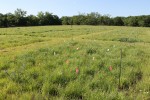Restoration ecology seeks to repair the diversity and dynamics of ecosystems degraded by human activities. Restoration studies in tallgrass prairie have become a core part of the Konza Prairie (KNZ) LTER program over the last decade, and are particularly timely because human activities have resulted in widespread loss and degradation of this ecosystem. This article presents an overview of three ongoing restoration studies that aim to develop and test hypotheses relevant to key issues in basic ecology while also addressing applied questions related to improving the structure, function, and sustainability of prairie restorations.
The first restoration experiment at KNZ was initiated in 1998, with a focus on the role of soil resource availability and heterogeneity (variability) in the restoration of plant community structure (diversity) and ecosystem processes. We manipulated levels and heterogeneity of two factors, soil depth and nitrogen availability, that are known to influence plant diversity in native prairie. This test of the ‘heterogeneity hypothesis’ demonstrated that nitrogen availability is a strong determinant of diversity in newly-restored grasslands, with high soil nitrogen increasing dominance of grasses at the expense of other species.
In the early years of this experiment, reducing available nitrogen reduced non-native species and promoted diversity. However, over a decade of study has revealed subsequent declines in plant diversity in all treatments (a common problem in restorations), but more species survived in plots with the most soil heterogeneity. Continued funding for this project is enabling us to assess longer-term trajectories of plant community and ecosystem recovery and test whether variability in community structure within an area and across time creates vacancies and resources that can promote biodiversity.
A second KNZ restoration experiment is part of a multi-site test of how different source populations of prairie grasses affect plant community composition and ecosystem functioning. We restored prairie using local ecotypes or cultivars of the dominant grasses, and then assessed whether intraspecific variation (i.e., the differences seen within species) occurred in several traits of the different source populations. Cultivars exhibited greater root length, surface area, and volume than local ecotypes of the grasses, and had equivalent or better physiological performance (i.e., net photosynthesis rate, stomatal conductance, and water use efficiency).
We are also evaluating how intraspecific variation from the source populations of these dominant species affects other species and ecosystem processes in developing communities. Our results so far indicate that biotic filters of the diversity of seeds sown and the selection of subordinate species have stronger effects on plant community structure and ecosystem functioning than the source population of the dominant grasses. These studies are providing important insights into how the choice of species and seed source can affect restoration outcomes.
Most recently, we initiated a long-term experiment on restoration chronosequence as part of our current KNZ LTER grant. In this experiment, we are restoring prairie in an agricultural field using the same species, seeding rates, and restoration techniques to examine the extent to which inter-annual variation in environmental conditions at the onset of a restoration affects the plant community. Controlling soil type, land-use history, seeding rates, species pools, and management will allow us to address the relative importance of stochastic events, such as climatic variability, which can affect initial seedling establishment and early community structure. The chronosequence will also allow us to more accurately quantify the recovery after disturbance of belowground species and rates of carbon accrual over time.
Collectively, the restoration studies at KNZ are providing insights into the roles of biotic (living) and abiotic (non-living) variation on the restoration of tallgrass prairie communities and associated ecosystem functioning. These studies will aid in developing more effective restoration approaches and enable us to better forecast the responses of restored grasslands to environmental change.

 Enlarge this image
Enlarge this image
